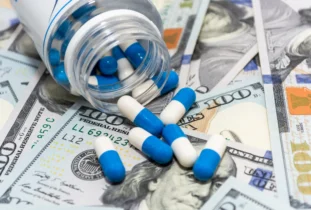Although pharmaceutical products have historically been protected during trade wars, President Trump continues to threaten a 25% U.S. tariff as part of his mission to boost domestic manufacturing. According to analysis conducted by Ernst & Young, this tariff would increase U.S. drug prices by nearly $51 billion per year.[1]
The components of manufacturing that would likely be subject to tariffs are:
- The active pharmaceutical ingredients (API), which represent the most expensive portion of drug production but account for a small fraction of the product sale price
- Plastics packaging, which is inexpensive individually but purchased in large quantities
- Fully finished goods produced by an owned or contracted facility, which represent the largest single cost of manufacturing
Model N believes a pharma tariff would most likely have the biggest impact on generic and over-the-counter (OTC) drugs versus branded drugs. That’s because the most significant factor affecting the price of a branded product is not the cost of the finished goods; it’s cost recovery for things like research and development, filing fees, and marketing.
On the other hand, generic products face significant price pressures due to multiple factors – market competition, distributor price concessions, and failure-to-supply risks. OTC products typically have the lowest individual price-per-unit sales and much smaller margins with similar manufacturing costs. Generic, OTC, and even smaller brand manufacturers that primarily take advantage of contract manufacturing from overseas companies will likely see the most significant price impact from tariffs due to their inability to absorb additional costs within their already low prices.
To understand the possible cost impacts, let’s look at a hypothetical example. Three manufacturers are each producing a drug with the same API and purchasing at least one manufacturing component from China. Assuming a 45% tariff is imposed on China, here’s what each manufacturer might expect:
| API cost from China (per bottle) | Bottle cost (per bottle) | Finished good upcharge (per bottle) | Cost per bottle before tariff | Cost per bottle after tariff | Expected cost increase | |
| Manufacturer 1 | $1 x 45% tariff = $1.45 | $0.12 from U.S. | $1.50 in U.S. | $2.62 | $3.07 | 17% |
| Manufacturer 2 | $1 x 45% tariff = $1.45 | $0.08 from China x 45% tariff = $0.12 | $1.50 in U.S. | $2.58 | $3.07 | 19% |
| Manufacturer 3 | $1 x 45% tariff = $1.45 | $0.08 from China x 45% tariff = $0.12 | $1.08 in China x 45% tariff = $1.57 | $2.16 | $3.14 | 45% |
Similarly, consumers would likely see the biggest impact at retail pharmacies for OTC products. For generic products, there may be some shakeup of the primary manufacturer for each product they buy – as distributors will begin to shift their generic buying to the lowest option available – but they’ll likely experience limited changes to the sale price.
Furthermore, for drugs without generic alternatives, pharma tariffs could make it impossible for vulnerable populations to access necessary medicine. For some drug companies, particularly foreign manufacturers shipping finished goods into the U.S. market, tariffs could make it impossible to continue participating in Medicaid and Public Health Service programs.
Implications of increasing drug prices
Manufacturers may be tempted to increase their prices in response to the tariffs; however, price increases pose multiple risks:
- Because the most significant contracts – including managed care and pharmacy benefits manager contracts, Medicaid pricing, the Federal Supply Schedule, and now Medicare – have price protection terms, any market price increase to recover tariff costs will likely be returned almost completely in rebates.
- The Consumer Price Index for All Urban Consumers (CPI-U) Penalty, also known as the “additional rebate,” will increase the Medicaid rebate unit amount if/when prices increase faster than inflation.
- Beginning this year, Medicaid will also implement inflation when companies raise prices faster than inflation.
- Managed care contracts include price protection rebates, which ensure a fixed net price. These rebates increase if prices rise, further impacting government prices and discounts by driving down the best-price value relevant for Medicaid.
- There is also the risk of reciprocal tariffs, which would drive higher U.S. prices to recover revenue lost due to reduced demand overseas.
Guidance for manufacturers
If you are a generic, OTC, or brand manufacturer and expect to be impacted by tariffs, start considering your options and prepare for negotiations to minimize cost increases. Remember to consider the switching costs of moving to any new supplier.
- Shop around for a U.S.-based contract manufacturer that can support your product.
- Look for lower-tariff overseas providers. Countries like Japan are investing significantly in drug manufacturing capabilities and may provide some cost savings over high-tariff countries.
- Negotiate with your current manufacturer to lower costs and remain where you are.
Once you understand the impacts of cost increases, assess any necessary price increases to maintain margins and protect net profit. Don’t forget to include the gross-to-net effects on top-line revenue due to these price changes. Price protection, distribution fees, failure to supply, and other penalties can create surprises if you’re not careful.
Model N Advisory Services can provide strategic and expert guidance to help you evaluate your options and navigate this evolving economic issue. Contact us for help with an assessment. In the meantime, Model N will closely watch the CPI-U to see if inflation grows due to tariff costs and provide relevant updates as developments occur.
As the landscape continues to evolve, more changes are on the horizon. Stay informed by revisiting this article and exploring updates like the recent developments discussed in CNBC’s coverage.
[1] NBC News. “Pharma tariffs would raise U.S. drug costs by $51 billion annually, report finds.” April 25, 2025.













